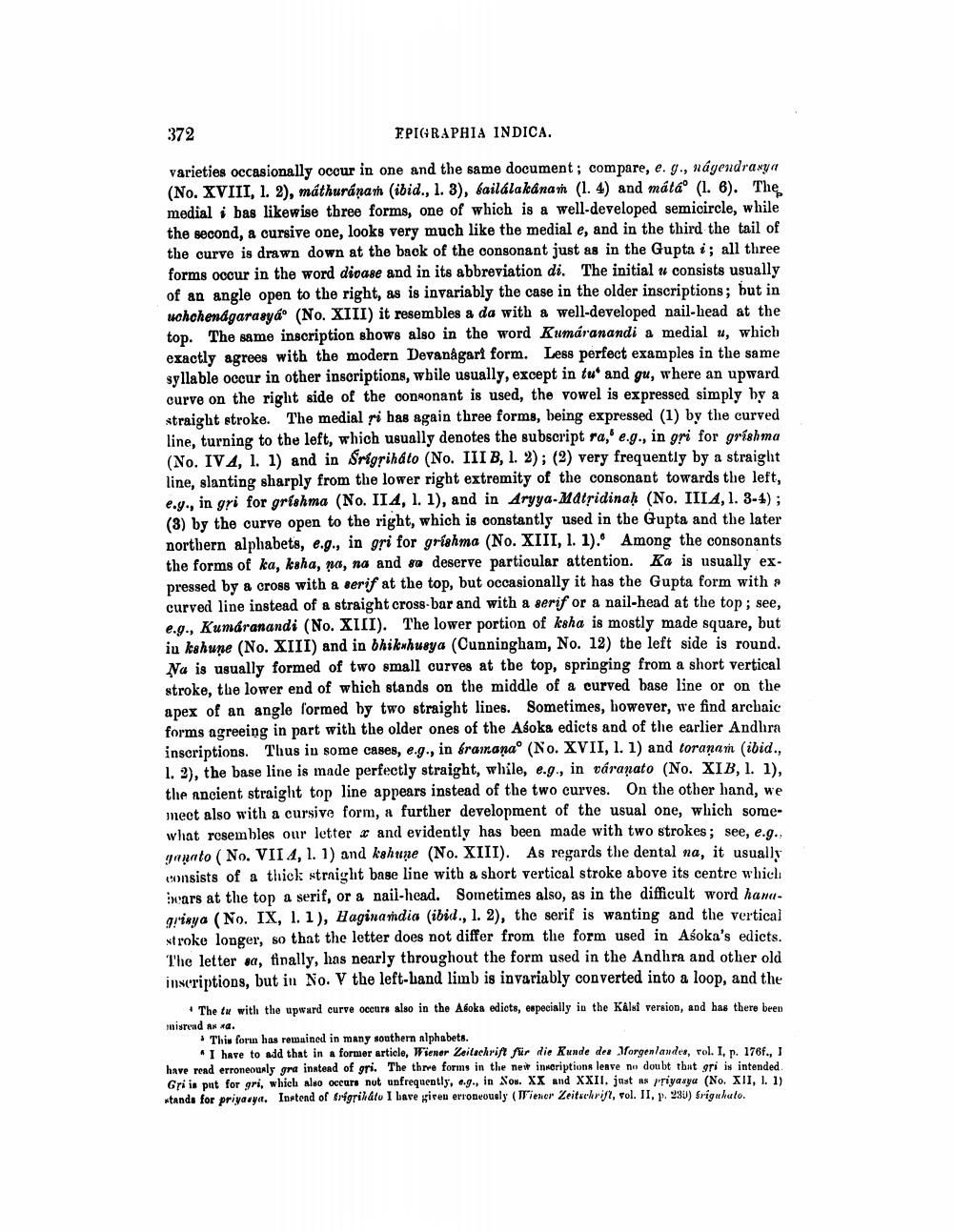________________
372
EPIGRAPHIA INDICA.
varieties occasionally occur in one and the same document; compare, e. g., nagendrasya (No. XVIII, 1. 2), máthuranam (ibid., 1. 3), bailálakánam (1. 4) and máta (1. 6). The medial bas likewise three forms, one of which is a well-developed semicircle, while the second, a cursive one, looks very much like the medial e, and in the third the tail of the curve is drawn down at the back of the consonant just as in the Gupta i; all three forms occur in the word divase and in its abbreviation di. The initial u consists usually of an angle open to the right, as is invariably the case in the older inscriptions; but in uchchendgarasya (No. XIII) it resembles a da with a well-developed nail-head at the top. The same inscription shows also in the word Kumaranandi a medial u, which exactly agrees with the modern Devanagari form. Less perfect examples in the same syllable occur in other inscriptions, while usually, except in tu' and gu, where an upward curve on the right side of the consonant is used, the vowel is expressed simply by a straight stroke. The medial ri has again three forms, being expressed (1) by the curved line, turning to the left, which usually denotes the subscript ra, e.g., in gri for grishma (No. IV4, 1. 1) and in Srigridto (No. IIIB, L. 2); (2) very frequently by a straight line, slanting sharply from the lower right extremity of the consonant towards the left, e.g., in gri for grishma (No. IIA, 1. 1), and in Aryya-Matridinah (No. III, 1. 3-4); (3) by the curve open to the right, which is constantly used in the Gupta and the later northern alphabets, e.g., in gri for grishma (No. XIII, 1. 1). Among the consonants the forms of ka, ksha, na, na and sa deserve particular attention. Ka is usually expressed by a cross with a serif at the top, but occasionally it has the Gupta form with > curved line instead of a straight cross-bar and with a serif or a nail-head at the top; see, e.g., Kumaranandi (No. XIII). The lower portion of ksha is mostly made square, but in kahune (No. XIII) and in bhikshueya (Cunningham, No. 12) the left side is round. Na is usually formed of two small curves at the top, springing from a short vertical stroke, the lower end of which stands on the middle of a curved base line or on the apex of an angle formed by two straight lines. Sometimes, however, we find archaic forms agreeing in part with the older ones of the Aśoka edicts and of the earlier Andhra inscriptions. Thus in some cases, e.g., in framana (No. XVII, 1. 1) and toranam (ibid., 1. 2), the base line is made perfectly straight, while, e.g., in varanato (No. XIB, 1. 1), the ancient straight top line appears instead of the two curves. On the other hand, we mect also with a cursive form, a further development of the usual one, which somewhat resembles our letter and evidently has been made with two strokes; see, e.g.. ganato (No. VII 4, 1. 1) and kehune (No. XIII). As regards the dental na, it usually consists of a thick straight base line with a short vertical stroke above its centre which bears at the top a serif, or a nail-head. Sometimes also, as in the difficult word hanagrisya (No. IX, 1. 1), Haginamdia (ibid., 1. 2), the serif is wanting and the vertical stroke longer, so that the letter does not differ from the form used in Aśoka's edicts. The letter sa, finally, has nearly throughout the form used in the Andhra and other old inscriptions, but in No. V the left-hand limb is invariably converted into a loop, and the
The tu with the upward curve occurs also in the Asoka edicts, especially in the Kalsi version, and has there been
misread as xa.
This form has remained in many southern alphabets.
I have to add that in a former article, Wiener Zeitschrift für die Kunde des Morgenlandes, vol. I, p. 176f., I have read erroneously gra instead of gri. The three forms in the new inscriptions leave no doubt that gri is intended. Gri is put for gri, which also occurs not unfrequently, e.g., in Nos. XX and XXII. just as priyasya (No. XII, 1. 1) stands for priyasya. Instead of frigrikáto I have given erroneously (Wiener Zeitschrift, vol. II, p. 230) Srigukato.




